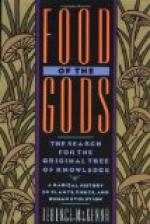[Illustration—Drawing: PODS OF CACAO THEOBROMA.]
From its twelfth to its sixtieth year, or later, each tree will bear from fifty to a hundred and fifty pods, according to the season, each pod containing from thirty-six to forty-two beans. Eleven pods will produce about a pound of cured beans, and the average yield of a large estate will be, in some cases, four hundredweight per acre, in others, twice as much. The trees bear nearly all the year round, but only two harvests are gathered, the most abundant from November to January, known as the “Christmas crop,” and a smaller picking about June, known as the “St. John’s crop.” The trees throw off their old leaves about the time of picking, or soon after; should the leaves change at any other time, the young flower and fruit will also probably wither.
Of the many varieties of the cacao, the best known are the criollo, forastero, and calabacilla. The criollo ("native”) fruit is of average size, characterized by a “pinched” neck and a curving point. This is the best kind, though not the most productive; it is largely planted in Venezuela, Columbia and Ceylon, and produces a bean light in colour and delicate in flavour. The forastero ("foreign”) pod is long and regular in shape, deeply furrowed, and generally of a rough surface. The calabacilla ("little calabash”) is smooth and round, like the fruit after which it is named. All varieties are seen in bearing with red, yellow, purple, and sometimes green pods, the colour not being necessarily an indication of ripeness.
[Illustration—Black and White Plate: Varieties of the Cacao.]
On breaking open the pod, the beans are seen clinging in a cluster round a central fibre, the whole embedded in a white sticky pulp, through which the red skin of the cacao-bean shows a delicate pink. The pulp has the taste of acetic acid, refreshing in a hot climate, but soon dries if exposed to the sun and air. The pod or husk is of a porous, woody nature, from a quarter to half an inch thick, which, when thrown aside on warm moist soil, rots in a day or two.




